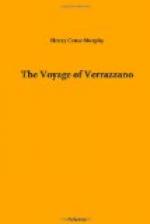It is thus established by the same testimony which furnishes the map of Lok, taken in conjunction with its own teachings, that it was not derived from the Verrazano map in its present shape, and does not represent the Verrazzano discovery.
The only evidence of the existence of the Verrazano map in any cosmographical production whatever, book, chart or globe, so far as known, independently of its history in the Borgian collection, is a copper globe, found by the late Buckingham Smith in Spain, a few years ago, and now in the possession of the New York Historical Society. This globe purports to have been constructed by Euphrosynus Ulpios in 1542. Inscribed upon it, in a separate scroll, is a dedication, in these words; “Marcello Cervino S. R. E. Presbitero Cardinali D.D. Rome.” Cervinus had been archbishop of Florence and was afterwards raised from the cardinalate to the pontificate under the title of Marcellus II. This globe represents the western sea in the same form as it is on the Verrazano map, and contains a legend on the country lying between the isthmus and Cape Breton, in these words: “Verrazana sive Nova Gallia a Verrazano Florentino Comperta anno sal. M.D.” In all other respects it differs essentially from the map in its description of the coast. Florida and Cape Breton are laid down in their true positions, and the isthmus occurs at the parallel of 33 degrees N. latitude, instead of 41 degrees. The direction of the coast, between the two points just mentioned, is more northerly, and the length of it consequently much reduced. The names along the coast, so far as the photograph of the map furnishes the means of comparison, are entirely different, except that Piaggia de Calami appears north of the isthmus. Dieppa and Livorno are not found upon it. But the legend affords indubitable evidence that the Maker had consulted the map. The name of Verrazana applied to the land is found no where else no applied, except on the map. But the incompleteness in which the date of the discovery is left, us if written 15—, proves that the maker was unable to ascertain it fully from his authority; the map, therefore, must have been his sole authority.




